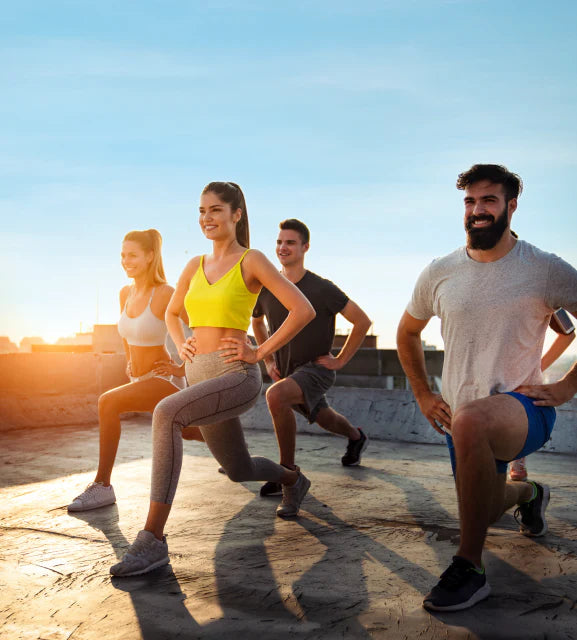ESN FITNESS INDEX 2024
A LOOK AT GERMANY'S FITTEST CITIES
Did you know? Germans love sports. In a European comparison, Germany is one of the leading fitness markets and has the second highest number of gym memberships after Great Britain, with an impressive 10.3 million. According to an AWA study from 2023, 53% of the population are interested in sports, with 19% even describing themselves as particularly sports enthusiasts.
And for which sports exactly? In addition to classic fitness training, according to a TK study, cycling, jogging and hiking are also among the absolute favorite sports. Exciting! But we wanted to know more and therefore investigated the question of where the most athletic Germans live. Discover our exclusive ESN Fitness Index 2024 for the most athletic cities in Germany below. Ready, set, go!

THE BEST FITNESS HOTSPOTS IN GERMANY
For our ESN Fitness Index 2024, we challenged 50 cities based on 11 relevant criteria . We not only looked at how many gyms, climbing halls and swimming pools a city has to offer, but also included criteria that affect general health and fitness. These include, for example, air pollution, the number of sports physicians and the proportion of green and recreational areas.
To keep the ranking as fair and representative as possible, we included at least three cities from each federal state and categorized and calculated the number of sports facilities, sports physicians and fast-food restaurants per 100,000 inhabitants.
The result? Our ESN fitness score! This tells you how fit a city is. You can get more information about the categories if you hover over the category. Cities with the same score are listed alphabetically. If you are particularly interested in a certain category, click on it to filter the ESN fitness index accordingly. Have fun exploring!
ESN FITNESS INDEX 2024
These are the top 10 sportiest cities in Germany
Smaller cities have fewer sports facilities overall than large cities like Berlin and Hamburg, but also fewer residents. This means more space, e.g. in gyms, yoga studios and swimming pools. Since we also take into account a factor such as fine dust pollution, smaller cities with less traffic and industry are clearly at an advantage. In addition to sports facilities, the environment has a major influence on our fitness goals and health.

NO BERLIN, MUNICH & HAMBURG IN THE TOP 10
Berlin, Hamburg or Munich? In fact, the largest cities are not the most sporty: smaller cities such as Kassel, Freiburg and Kiel lead the ranking and show that size is not everything. Among the top 10 there are four cities with fewer than 200,000 inhabitants and no city with more than 400,000 inhabitants. Munich, the first city with more than a million inhabitants, is in seventeenth place.

MANY SPORTS FACILITIES BUT STILL NO TOP SCORE
Berlin may be full of life and sports facilities (e.g. an impressive 606 fitness studios, including smaller gyms run by personal trainers), but per 100,000 inhabitants, that's not enough to rank at the top. For comparison: In Berlin, there are 16 fitness studios per 100,000 inhabitants, in Regensburg there are 29, and in Merzig in Saarland there are even 30. But wait a minute, Berlin is at least in first place in terms of the proportion of green spaces, with an impressive 13.5% of the city area. That sounds like a lot of relaxation and fresh air, doesn't it? Well, unfortunately not quite, because the capital still has the highest PM10 concentration in Germany at 24µg/m³. Berlin, you still have potential for more sport and fresh air!

NO BERLIN, MUNICH & HAMBURG IN THE TOP 10
Berlin, Hamburg or Munich? In fact, the largest cities are not the most sporty: smaller cities such as Kassel, Freiburg and Kiel lead the ranking and show that size is not everything. Among the top 10 there are four cities with fewer than 200,000 inhabitants and no city with more than 400,000 inhabitants. Munich, the first city with more than a million inhabitants, is in seventeenth place.
GERMAN CITIES IN COMPARISON
Where do you breathe the purest air?*
FINE DUST POLLUTION:
In Germany, declining for years*

DISCOVER GERMANY'S TOP CITIES IN TERMS OF RECREATIONAL AND SPORTS AREAS
Green spaces, sports and recreational areas increase the quality of life in a city. Parks and urban forests in particular are not only popular places to retreat to escape the hustle and bustle of the city, but they also do a great job of filtering pollutants and producing fresh oxygen. In terms of the proportion of such areas, Berlin is at the forefront. The capital benefits from its many parks, green spaces and adjacent forests such as the Grunewald. Halle an der Saale and Magdeburg come in just behind.
The top two places for cities that have a proportionally smaller area of green, sports and recreational areas are the Saarland cities of Merzig and Neunkirchen an der Saar. However, both cities are embedded in nature, which means that residents can quickly get out into the countryside, for example. However, the natural surroundings are not part of the urban area - one of the reasons why smaller cities in particular do not do so well in this category.
SPORTS, LEISURE AND RECREATIONAL AREA*
How Germany’s cities compare
GERMAN CITIES IN THE FAST FOOD CHECK
WHERE IS THE DRIVE-IN DENSITY HIGHEST?
According to a YouGov survey from 2022 , 26% of Germans are increasingly turning to fast food, especially on stressful days. And even if a sinful snack here and there sounds tempting, various studies show the serious consequences that regular fast food consumption can have. A look at the density of fast-food restaurants in German cities shows that while Berlin is ahead in absolute numbers with 90 branches of the Burger King, KFC, McDonald's, Nordsee and Pizza Hut chains, Neunkirchen an der Saar has the most branches per 100,000 inhabitants with 14.5. The fast-food desert of Duisburg, on the other hand, takes first place in our ranking with only 1.8 branches of the common franchises per 100,000 inhabitants.
But why do so many people keep eating fast food? It's simple: it's quick, it's popular and it's available everywhere. The problem: fast food is usually high in calories and low in nutrients, full of unhealthy fats, sugar and salt - and often only keeps you full for a short time.
Our tip: For all those who, on hectic days, do not want to supply their body with empty calories from nutrient-poor fast food, but with valuable nutrients such as proteins, our protein powders , delicious protein bars and other
Nutrient-rich snacks are an ideal way to quickly and easily enjoy delicious taste, consume valuable proteins and thereby support your muscles and stay full for longer - ideal as snacks and in addition to a balanced diet.
MCDONALDS, KFC, BURGER KING, PIZZA HUT & CO*
In which cities does fast food have a place (or no place)?
FROM SMALL TOWN TO METROPOLIS
THE LOVE OF SPORT AND EXERCISE IS EVERYWHERE
Our ranking shows one thing: It's not (just) size that matters. From Merzig to Berlin, Germans have countless opportunities to invest in their health and fitness. In January in particular, many people decide to turn their lives around. The ESN Fitness Index 2024 shows you that - no matter where you are - the world is just waiting to become your fitness place. It doesn't matter whether you want to go to the gym, dance, do yoga, play football or enjoy a walk through the park. The important thing is that you take the first step and don't let yourself get discouraged. Your potential is limitless. Now, move!
Sources
1. European Health Fitness Market Report 2023 (EuropeActive, Deloitte): https://www.europeactive.eu/news/2023-european-health-fitness-market-report-strong-growth-memberships-and-revenues-2022
2. Survey in Germany on interest in sport until 2023 (Allensbach Market and Advertising Analysis): https://www.ifd-allensbach.de/awa/startseite.html
3. Movement Study 2023 (TK): https://www.tk.de/techniker/magazin/sport/spezial/raus-und-los/studie-beweg-dich-deutschland-das-land-der-sportmuffel-2141030?tkcm=aaus
4. Regional Atlas of Germany (Federal and State Statistical Offices): https://www.statistikportal.de/de/karten/regionalatlas-deutschland
5. Bäderatlas (German Society for Bathing): https://baederatlas.com/
6. Climbing hall search (German Alpine Association): https://www.alpenverein.de/thema/kletterhallensuche#/
7. Courts of the World: https://www.courtsoftheworld.com/germany/
8. IQair: https://www.iqair.com/de/
9. PM10 annual report 2022 (Federal Environment Agency): https://www.umweltbundesamt.de/daten/luft/feinstaub-belastung
10. YouGov study on fast food: https://www.presseportal.de/pm/139186/5272606
11. 11880.com
12. Google Maps












